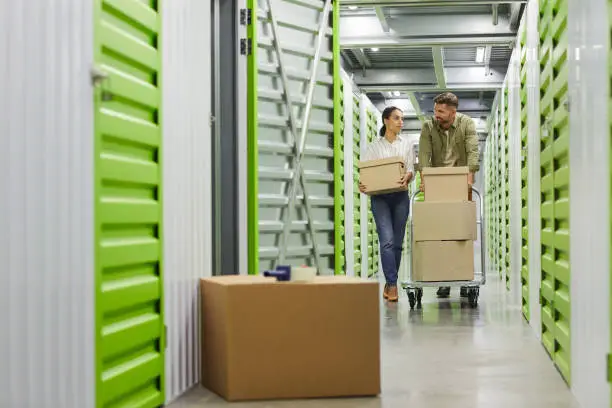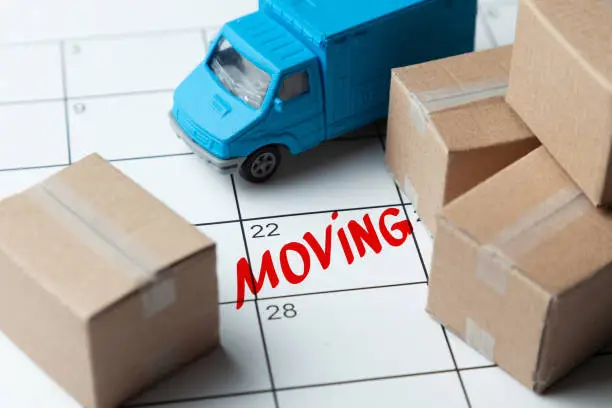How To Use Temporary Storage During a Move

When embarking on the tumultuous journey of moving, one question often looms large: “Where do I keep my belongings during this transition?” Whether you’re downsizing, waiting for your new home to be ready, or simply want a clearer space to streamline the moving process, temporary storage becomes the unsung hero. Understanding how to use temporary storage during a move can transform a chaotic experience into a seamless transition, giving you peace of mind.
With an array of storage solutions available today, from classic storage units to portable containers that come right to your doorstep, the options can be overwhelming. This guide will demystify the world of temporary storage for moving, offering insights, tips, and strategies to make your move as smooth as possible. Whether you’re a seasoned mover or a first-time homeowner venturing into new territories, we’ve got the information you need to navigate the world of storage with confidence.
Stay with us as we delve deep into the realms of storage spaces, units, containers, and more, ensuring your next move is efficient, cost-effective, and stress-free.
Understanding Different Types of Storage Options

Moving is more than just packing and unpacking; it’s about making strategic choices to ensure the safety and accessibility of your belongings. Let’s explore the diverse storage options available:
- Storage Units & Self-Storage Units: These are spaces you can rent, typically on a month-to-month basis. Think uhaul, or u haul. Also known as storage container companies, they come in various sizes, catering to different storage needs. While a storage unit is a broad term, a self-storage unit refers specifically to spaces that you can access and manage yourself, giving you the autonomy to access your belongings whenever you need.
- Storage Containers & Portable Storage Containers: Think of these as your movable storage units. Instead of taking your items to a storage facility, the portable storage container, or storage container, comes to you. Particularly, portable storage containers, like PODS containers, or Upack, are delivered to your location, and once filled, can be stored on your property or transported to a facility.
- Short-Term Storage Facilities vs. Long-Term Storage: Your storage duration matters. If you need to store items during a short transition phase, short-term storage facilities are ideal. However, if your belongings need a home for several months or more, considering long-term options is crucial.
- Climate-Controlled Units: Some items are sensitive to temperature and humidity. Climate-controlled storage provides a stable environment, preventing damage from extreme temperatures or moisture. These units are particularly crucial if you’re storing art, electronics, important documents, or other sensitive items.
- Public Storage: Self storage facility, or self storage facilities are widely available and popular. Public storage offers spaces in various sizes and types, often boasting added features like climate control and humidity control. They’re a reliable choice for those seeking convenient and flexible storage solutions.
- Significance of Storage Space: Always remember, the amount of storage space you choose affects not just the cost but also the safety and accessibility of your items. Cramping too many items in a smaller space might save money, but it can compromise the condition of your belongings.
How to Choose the Right Storage for Your Needs

Choosing the perfect storage solution requires a mix of foresight, research, and understanding your unique needs. Here are key factors to consider:
- Deciding How Much Space You Need: Begin by taking inventory. Categorize items based on size, fragility, and frequency of access. This will help you gauge the right unit size. Remember, while you may be tempted to cram everything into a smaller unit for cost savings, you should ensure there’s enough space to access items without causing damage.
- Storage Rates and Cost Factors: Like all services, storage comes at a price. Explore storage rates in your vicinity, and compare them based on size, features, and reviews. Sometimes paying a little extra for a climate-controlled unit or better security is worth the peace of mind.
- Top-Notch Security: Your belongings are invaluable, and their security is paramount. Ensure the storage facility has top-notch security measures like surveillance cameras, security guards, and secure access systems.
- Climate-Controlled Storage vs. Regular Storage: As mentioned, some items require a stable environment. If you’re storing books, electronics, wooden furniture, or any sensitive items, it’s advisable to invest in climate-controlled storage.
- Considering Accessibility: How often do you anticipate needing access to your stored items? If frequent, choose a facility that offers easy access, with flexible hours or even 24/7 access. Some facilities might have restrictions, so always check in advance.
- Duration of Storage: Whether it’s short-term storage during a home renovation or long-term storage as you move abroad, the duration influences your choice. For instance, short-term storage solutions might offer more flexibility and accessibility, while long-term options might be more cost-effective for extended periods.
By honing in on your specific needs and doing diligent research, you can ensure that your storage choice is both practical and cost-effective. It’s not just about storing; it’s about storing smartly.
Tips for Storing Specific Items

Every item in our possession holds value, be it sentimental or monetary. Hence, understanding the nuances of storing various items can make a significant difference in preserving their integrity. Here’s a rundown on how to ensure the longevity and safety of different items:
- Storing Furniture: Furniture, particularly wooden ones, can be vulnerable to temperature fluctuations and humidity. Before placing them in a storage unit, clean and disassemble if possible. Use protective covers and avoid placing them directly on the floor. If you’re planning to store furniture for an extended period, consider climate-controlled units to prevent warping or mold growth.
- Keeping Important Documents Safe: Documents like birth certificates, property deeds, or financial records need special attention. Store them in waterproof containers or plastic sleeves. Consider a climate-controlled unit to prevent damage from humidity.
- PODS Containers for Fragile Items: Fragile items like glassware, artwork, or electronics benefit from the protective confines of PODS containers. They’re sturdy and can be packed tightly with padding materials, ensuring minimal movement and maximum protection.
- Weather-Resistant Storage for Outdoor Items: For items like garden tools, BBQ grills, or bicycles, weather-resistant storage is essential. Clean them thoroughly to remove any residual dirt or moisture and protect them with covers or tarps.
- Household Items and Appliances: Appliances should be cleaned and dried to avoid mold growth. Defrost freezers and refrigerators. For electronics, consider their original packaging, which is designed to protect the item during transit and storage.
Moving and Storage: Hand in Hand

The relationship between moving and storage is like a well-choreographed dance. When executed with thought and precision, it results in a harmonious transition. Here’s how the two intertwine:
- Moving Companies Offering Storage Options: Many moving companies understand the diverse needs of relocators. As such, they offer integrated moving and storage services. This can be especially useful if there’s a gap between your move out date and the day you can move in to your new house.
- Flexibility in Transition: Moving and storage solutions combined offer flexibility. Whether your new home isn’t ready or you’re moving in phases, storage ensures your items are safe and accessible.
- Cost-Effective Solutions: By leveraging bundled services from moving companies, you can often enjoy discounted rates. This combination can be more cost-effective than hiring separate entities for moving and storage.
- Streamlined Logistics: When your moving company is also responsible for your storage, it reduces the logistical challenges. They can ensure that items are stored in a manner that makes it easy to transport them again, reducing handling and potential damage.
- Planning and Packing: Understanding storage during the moving house phase can influence how you pack. For items going into short-term storage, pack them in a way that they’re easily accessible. For longer storage durations, ensure they’re packed for optimal preservation.
By recognizing the symbiotic relationship between moving and storage, you can craft a strategy that ensures both processes complement each other, leading to a smoother and more efficient relocation.
Benefits of Temporary Storage During a Move
The use of temporary storage during a move might initially seem like an extra step. Still, once you delve into the manifold benefits it offers, it’s evident why so many opt for this solution. Here’s what makes temporary storage a game-changer:
- Decluttering and Organizing: Temporary storage allows you to keep non-essential items out of the way, making it easier to sort, pack, and transport essentials during the move. This decluttered environment can significantly reduce the stress associated with moving.
- Flexibility in Timing: Not all moves are perfectly timed. Perhaps your new home isn’t ready, or there are unforeseen delays. In such cases, short-term storage offers a buffer, ensuring your items are safe while you sort out the logistics.
- Protecting Valuables: Storage facilities often come with top-notch security features, from surveillance cameras to on-site guards. Your valuables, therefore, might be safer in a storage unit than in transit or in a home that’s constantly open due to moving activities.
- Cost-Effective Solutions: Depending on the situation, renting a storage space might be more economical than rushing a move or paying for extended rental days on a moving truck.
- Ease in Renovation or Home Sale: If you’re moving because you’ve sold your home or you’re moving into a place that needs renovations, temporary storage solutions allow you to clear spaces, making it easier for work to be done or for a staged home to look its best.
Things to Keep in Mind

While temporary storage provides numerous advantages, there are essential pointers to keep in mind to optimize your experience:
- Insurance: Before storing items, especially valuables, check with the storage facility about insurance coverage. While many provide basic coverage, it might be prudent to consider additional insurance for peace of mind.
- Storage Duration: It’s easy to forget items once they’re out of sight. If you’re using short-term storage, set reminders or alarms to review the need periodically, ensuring items don’t stay stored longer than necessary.
- Regular Checks: Even in the best storage facilities, it’s wise to periodically check on your items. This helps in detecting any potential issues, like moisture buildup, early on.
- Proper Labeling: This cannot be stressed enough. Label every box or container. If you need to retrieve something, proper labels will save you from the ordeal of rummaging through dozens of boxes.
- Accessibility: Choose a storage facility that’s convenient in terms of location and access hours, especially if you anticipate frequent visits.
- Terms and Conditions: Read the fine print. Some storage facilities might have clauses about early move-outs, late payments, or other specific conditions that you should be aware of.
- Packing Supplies: Invest in quality packing supplies. The right boxes, bubble wrap, and tapes can significantly influence the condition in which your items remain while stored.
Storage, especially during the tumult of a move, can be a sanctuary for your belongings. However, the best results come from an informed approach, so always be diligent, plan well, and prioritize the safety of your items.
R&H Distressed Properties: Your Go-To Cash House Buyers

In the ever-evolving world of real estate, there’s a growing demand from homeowners saying, “I need to sell my house fast.” Whether it’s due to unforeseen circumstances, the desire to avoid prolonged listing processes with real estate agents, or the need to unload a fixer upper, homeowners are looking for swift, reliable solutions. This is where R&H Distressed Properties, one of the best companies that buy houses for cash, steps in to change the game.
Why Choose R&H Distressed Properties?
- Fast Cash Offers: One of the hallmarks of R&H Distressed Properties is the speed with which they operate. If you’re thinking, “I want to sell my house fast for cash,” this home buying company is your answer. They make a cash offer on house listings promptly, ensuring you get your money without delays.
- Bypass Traditional Agents: With R&H Distressed Properties, you can sidestep the traditional real estate agent route. They act as a direct buyer, which means no more waiting for an intermediary or paying hefty agent commissions.
- No Need for Repairs: Got a fixer upper or a property that has seen better days? No problem. R&H Distressed Properties operates on a “we buy houses” model, regardless of their condition. Whether your home is pristine or needs some TLC, they’re interested.
- Zero Closing Costs: With many real estate transactions, closing costs can be a considerable pain point. However, when dealing with these California house buyers, the process is streamlined, often resulting in reduced closing expenses.
- Expertise in Distressed Homes: Whether it’s a rental property that’s causing you grief or a home that’s seen significant wear and tear, R&H Distressed Properties is your go-to. Their motto, “we buy homes”, isn’t just a catchphrase; it’s a commitment.
- No Listings, No Waiting: Thinking, “I need to sell home fast?” With R&H Distressed Properties, there’s no need to list your home and wait. They buy houses California residents are eager to sell, often closing deals faster than traditional methods.
- Transparent Process: R&H Distressed Properties believes in a transparent, straightforward process. There’s no hidden agenda or fine print. Whether you want to sell house quickly or you’re just exploring your options, they’re here to help.
For many homeowners, the traditional route of listing a home, working with real estate agents, and waiting for the right buyer can be tedious. But, when you’re saying, “I want to sell quick,” or “I need to sell house quick for an upcoming move”, R&H Distressed Properties is the answer. As one of the premier cash home buyers in the industry, they’ve revolutionized the real estate landscape. With their commitment to buying houses swiftly, coupled with their expertise in handling homes in any condition, they’ve emerged as the ideal solution for those looking to get fast cash for their properties.
So, if you’re in the market thinking, “It’s time to sell my house fast cash,” R&H Distressed Properties should be your first call. Your home, regardless of its condition, has a buyer waiting. And that buyer is R&H Distressed Properties.
Conclusion: Finding Peace in the Moving Process
Relocating can often be a whirlwind of emotions and tasks. From selecting the best moving company to ensuring our cherished belongings are safely stored, each step carries its own set of challenges. However, knowledge is the key. By understanding your storage options, knowing the benefits of temporary storage, and even opting for services like those offered by R&H Distressed Properties for a quick home sale, you can make your move considerably smoother.
Incorporating temporary storage solutions isn’t just about finding more space; it’s about buying peace of mind during a transformative phase of life. The right storage option can declutter your environment, both physically and mentally. Similarly, opting for a direct buyer when selling your home can save time, money, and unneeded stress.
Remember, moving is more than just a change of address. It’s a new chapter, filled with opportunities and fresh starts. So, as you turn the page, ensure you’re equipped with the right information, resources, and partners. Whether it’s a storage facility or self storage companies for your prized possessions, a trusted real estate agent for guidance, or a cash offer from R&H Distressed Properties to fast-track your home sale, make choices that serve your best interests.
Happy moving and here’s to new beginnings!
Frequently Asked Questions (FAQ)

1. How do I prepare for a short-term move?
Answer: Preparing for a short-term move primarily involves efficient planning and packing due to the temporary nature of the relocation. Here are some steps to help:
- Inventory & Prioritize: List all items you own and decide which ones are essential for your short-term location.
- Pack Essentials First: Items like daily wear clothes, necessary kitchen gadgets, and important documents should be packed first.
- Renting vs. Buying: Given the temporary nature, consider if renting some items at the new location is more feasible than moving them.
- Notify Important Contacts: Inform your bank, postal service, and other vital contacts about your temporary move.
- Seek Storage: Since it’s a short-term move, consider using temporary storage for items you won’t need immediately.
2. What is temporary storage?
Answer: Temporary storage refers to a storage solution where individuals or businesses can store their belongings for short periods. This can range from a few days to several months. The storage might be in the form of storage units at a storage facility, portable storage containers, or even specialized spaces like climate-controlled units for sensitive items. Temporary storage is particularly useful during moves, home renovations, or any situation where you might need to free up space temporarily.
3. How do I move things to storage?
Answer: Moving things to storage requires some foresight to ensure that your items remain in good condition. Follow these steps for a smooth transition:
- Choose the Right Storage: Depending on what you’re storing, you might need special storage solutions like climate-controlled units. For instance, wood furniture and electronics are best stored in such units to prevent damage.
- Pack Properly: Use quality packing supplies. Items should be clean, dry, and well-wrapped. Cardboard boxes, plastic bins, bubble wrap, and packing tape are essentials.
- Label Everything: Clearly label boxes based on their contents. This will make retrieval easier and ensure that fragile items are easily identifiable and treated carefully.
- Transportation: Depending on the volume, you can use your vehicle, rent a truck, or even hire professional movers. Ensure items are securely placed to avoid damages during transit.
- Arrange Items Thoughtfully: In the storage unit, place items you might need to access more frequently at the front. Ensure there’s a clear path to walk, and leave some space for ventilation.
Remember, whether it’s a short-term move, understanding temporary storage, or moving items to a storage space, adequate planning and careful execution make all the difference.